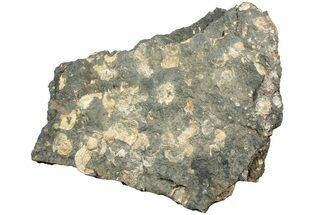4.2" Pennsylvanian Fossil Flora Plate - Kentucky
This is a beautiful fossil flora plate containing numerous impressions of ferns, including Neuropteris species as well as a Lepidodendron (scale tree) branch impression. It was collected from the Breathitt Formation of Leslie County, Kentucky. This formation is a part of the Late Carboniferous, Pennsylvanian age forests that formed the coal shales of Kentucky and Ohio.
It comes with an acrylic display stand.
It comes with an acrylic display stand.
Neuropteris is an extinct genus of fern that reproduced from seed as opposed to sporophyte reproduction like most modern ferns. As with most seed ferns, Neurodontopteridaceae grew in tree form.
Annularia is the form genus of leaf clusters of tree-like sphenophytes (horsetails) known as Calamites.
Leaves on Calamites trees formed in clusters of 8 or more, called whorls, at spaced nodes along stems. Annularia indicate flat, starburst-shaped whorls, but the shapes of the leaves themselves could vary from oval (A. sphenophylloides) to lanceolate or needle-like (A. radiata). They can also be identified by midline veins throughout the leaf from node to leaf tip.
We use these terms to describe the shapes of fossil imprints. Exact species are often difficult to determine, but these form taxa help to distinguish the prolific species of sphenophytes that defined the Carboniferous Period.
Leaves on Calamites trees formed in clusters of 8 or more, called whorls, at spaced nodes along stems. Annularia indicate flat, starburst-shaped whorls, but the shapes of the leaves themselves could vary from oval (A. sphenophylloides) to lanceolate or needle-like (A. radiata). They can also be identified by midline veins throughout the leaf from node to leaf tip.
We use these terms to describe the shapes of fossil imprints. Exact species are often difficult to determine, but these form taxa help to distinguish the prolific species of sphenophytes that defined the Carboniferous Period.
Lepidodendron, also known as scale trees, were primitive vascular plants, thriving in the swampy environments of the Carboniferous Period about 350 to 300 million years ago. Their closest modern relatives are club mosses. They reached heights comparable to modern trees, sometimes as high as 50 meters, or roughly 160 feet.
However, unlike most modern trees their growth habit was dichotomous: younger plants grew as a single stem, from which leaves protruded directly from the trunk. As they aged, the growing ends would split into new branches, eventually creating a fractal pattern similar to modern dragon trees.
Lepidodendron grew needle-like leaves from scale-like bases along stems, from which the plants are named. At the ends of branches were oval-shaped cones similar in shape to modern cones of a spruce or fir. These cones bore spores, and only grew from the crown.
Lepidodendron may have also been among the first plants to form mycorrhizal relationships with fungi, as fossil evidence between Lepidodendron "roots" (identical to stem tissues) and early fungal organisms has been found.
However, unlike most modern trees their growth habit was dichotomous: younger plants grew as a single stem, from which leaves protruded directly from the trunk. As they aged, the growing ends would split into new branches, eventually creating a fractal pattern similar to modern dragon trees.
Lepidodendron grew needle-like leaves from scale-like bases along stems, from which the plants are named. At the ends of branches were oval-shaped cones similar in shape to modern cones of a spruce or fir. These cones bore spores, and only grew from the crown.
Lepidodendron may have also been among the first plants to form mycorrhizal relationships with fungi, as fossil evidence between Lepidodendron "roots" (identical to stem tissues) and early fungal organisms has been found.
SPECIES
Neuropteris sp. & Lepidodendron sp.
LOCATION
Leslie County, Kentucky
FORMATION
Breathitt Formation
SIZE
4.2 x 3.95" rock
CATEGORY
ITEM
#258806
We guarantee the authenticity of all of our specimens.
 Reviews
Reviews












